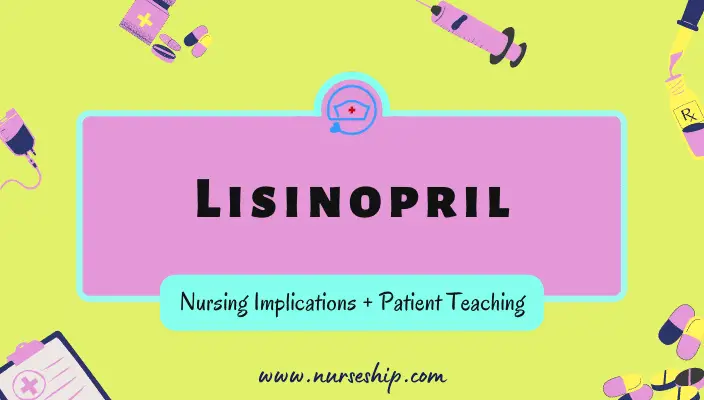Introduction
In this article, you’ll learn about vancomycin nursing implications and patient teachings. Its dosage, mechanism of action, indication, contraindications, interactions, and side effects are also discussed.
Vancomycin was discovered in 1950 and is derived from Amycolatopsis Orientalis, a soil bacterium. This glycopeptide antibiotic works against gram-positive bacteria, primarily staphylococcal and MRSA strains.
Vancomycin is used to treat serious or life-threatening infections caused by susceptible methicillin-resistant (beta-lactam-resistant) staphylococci strains. It is also used to treat patients who are allergic to penicillin or infections that don’t respond to other antibiotics, like penicillins or cephalosporins.
Vancomycin is also indicated in endocarditis caused by gram-positive bacteria such as Streptococcus viridans, Streptococcus bovis, Staphylococcus epidermidis, and Enterococcus faecalis.
Vancomycin is available in oral and parenteral forms. Oral preparations are effective only in cases of Clostridium difficile-associated diarrhea (CDAD) or Staphylococcus aureus enterocolitis. All other infections require parenteral administration.
Generic Name: Vancomycin
Brand Names: Firvanq, Vancocin, Vancocin HCl
Vancomycin Class and Category
Pharmacologic class: Tricyclic glycopeptide antibiotic
Therapeutic class: Antibiotic
Pregnancy category: B (oral); C (parenteral)
Vancomycin Dosage
The dosage of vancomycin is adjusted based on the needs of the patient. Vancomycin’s usual dosages for adults and children are as follows.
Adults:
PO: 125 – 500 mg in divided doses for 7 – 10 days. Maximum dose: 2 g/day.
IV infusion: 30 mg/kg in divided doses for 4 – 6 weeks. Maximum dose: 2 g/day.
Pediatrics:
PO: 40 mg/kg in divided doses for 7 – 10 days. Maximum dose: 2 g/day.
IV infusion (children 1 month – 12yrs): 20-60 mg/kg, q6–8h.
IV infusion (neonates): initially15 mg/kg, then 10 mg/kg q6–24h.
* Remember that parenteral vancomycin should be administered very slowly at least over 1 hour or not more than 10 mg/minute.
Vancomycin Pharmacokinetics and Pharmacodynamics
| Route | Onset | Peak | Duration |
| IV | Immediate | 1 hour | 12 – 24 hours |
Absorption: Oral vancomycin is poorly absorbed from the GI tract.
Distribution: Protein binding is 10%–50%. Parenteral vancomycin is widely distributed.
Metabolism: No active metabolism.
Half-life: 4 – 11 hours (increased in patients with renal disease).
Excretion: oral vancomycin is eliminated in the feces. While parenteral vancomycin is excreted unchanged in the urine.

Human Anatomy & Physiology Course
- Guidebooks
- Complete Diagrams & Lessons
- Certifications
- Quiz & Answers
- And More…
Vancomycin Mechanism of Action
Vancomycin is a glycopeptide antibiotic that kills gram-positive bacteria by preventing peptidoglycans in the cell wall from polymerizing.
It binds to the part of the bacterial cell wall called acyl-D-ala-D-ala. Then it stops N-acetylmuramic acid (NAM) and N-acetylglucosamine (NAG) synthesis by inhibiting glucosyltransferase (peptidoglycan synthase) and P-phospholipid carrier.
This inhibition weakens bacterial cell walls, allowing internal cell components to leak out and finally killing the bacteria.
Vancomycin has a bactericidal therapeutic effect.
What are the indications of Vancomycin?
Vancomycin indications include:
1. Treatment of serious infections caused by Methicillin-resistant Staphylococcus aureus (MRSA) and MRSE (multidrug-resistant Staphylococcus epidermis)
2. Treatment of infections caused by gram-positive bacteria. Such as:
- Enterocolitis caused by Staphylococcus aureus and MRSA
- Diarrhea caused by Clostridium difficile
- Infections of the skin caused by Staphylococci
- Infections caused by Gram-positive bacteria, such as bone infections, septicemia, and lower respiratory infections.
- Staphylococcal endocarditis
- Ventilator-associated pneumonia (VAP), catheter-associated urinary tract infections (CAUTI), central line-associated bloodstream infections (CLABSI), surgical site infection (SSI), and bacteremia.
- Prophylactic therapy for post-procedural endocarditis.
What are the contraindications of Vancomycin?
The contraindications of vancomycin are:
- Hypersensitivity to vancomycin and its components.
- Corn or corn product allergy when taken with dextrose.
Caution:
- Renal impairment
- pregnancy and lactation
- Geriatric patients
- Concomitant use of additional ototoxic and nephrotoxic drugs.
Vancomycin Interactions
- Concomitant use of amphotericin B, aminoglycosides, furosemide, bacitracin, polymixin B, colistin, viomycin, or cisplatin with vancomycin has a cumulative nephrotoxic and ototoxic effect.
- Antihistamines, buclizine, cyclizine, phenothiazines, thioxanthenes, and trimethobenzamide can obscure ototoxicity symptoms of vancomycin.
- Oral vancomycin’s antibacterial effectiveness is reduced with cholestyramine and colestipol.
- Concomitant use of vancomycin with nephrotoxic drugs increases risk of nephrotoxicity.
- Co-administration of vancomycin and anesthetic drugs may cause erythema, histamine-like flushing, and anaphylactoid reactions.
Lab interactions
- Vancomycin may cause elevated BUN and serum creatinine levels.
- Vancomycin may increase eosinophils while decreasing WBCs
Herbal/food interactions
Not known.
What are the side effects of vancomycin?
Vancomycin side effects / adverse reactions include:
- Unpleasant taste and irritation in the mouth (PO)
- Nausea and vomiting
- Diarrhea
- Fever
- Fatigue
- Rash
- Urticaria
- Back pain
- Dizziness
- Headache
- Abdominal pain
- Peripheral edema
- Tinnitus
- Leukopenia
- Eosinophilia
- Ototoxicity
- Phlebitis and IV site complications
Life-threatening adverse effects:
- Anaphylaxis
- Acute kidney injury (AKI)
- Interstitial nephritis
- Johnson syndrome
- Toxic Epidermal necrosis
- Hypotension
- Shock and Cardiac arrest
Vancomycin Nursing Implications [Nursing Considerations]
Vancomycin nursing implications are divided into nursing assessment, interventions, and evaluation.
Vancomycinnursing assessment
- Collect the health history and note any allergy to vancomycin.
- Assess for the interaction with any other antibiotics or medicines the client is taking.
- Assess vital signs and urine output.
- Confirm the client’s pregnancy or lactation status.
- Perform a baseline auditory assessment.
- Obtain baseline CBC and RFTs.
- Obtain C&S before initiating vancomycin therapy.
Vancomycin nursing diagnosis
- Risk for infection (indication)
- Risk for ineffective tissue perfusion (side effect)
- Risk for impaired tissue integrity (side effect)
Vancomycin nursing interventions/ actions
- Monitor heart rate and BP throughout during administration of Vancomycin.
- Maintain strict intake and output chart and check for any changes in urination, urine color, and pattern.
- Observe closely for signs (e.g., chills, fever, flushing of the neck, hypotension, tachycardia, and nausea and vomiting) of red-man syndrome during IV infusion.
- Evaluate the IV infusion site for signs of extravasation, such as necrosis, discomfort, soreness, and thrombophlebitis.
- Monitor serum levels of vancomycin, especially in patients with renal disease, colitis, and children. Therapeutic serum level: peak: 20–40 mcg/mL; trough before next dose: 10–20 mcg/mL. Toxic serum level: peak: more than 40 mcg/mL; trough before next dose: more than 20 mcg/mL.
- Monitor serum creatinine, BUN, and CBC levels on a regular basis during vancomycin therapy, especially if the patient has renal disease or is on an aminoglycoside. Because systemic vancomycin may result in AKI.
- Regularly assess the patient’s hearing ability during vancomycin therapy.
- Ensure adequate hydration status to prevent nephrotoxicity.
- Notify the physician in case of any allergic manifestations.
IV administration considerations for vancomycin
- Reconstitute vancomycin 500mg and 1 g vial by adding 10 ml and 20 ml of sterile water for injection, respectively. Then, using a compatible solution, make a final concentration of 500mg/100ml and 1g/200ml.
- Infuse the reconstituted vancomycin over 1 hour or not more than 10mg/minute. Rapid infusion can result in red-man syndrome, anaphylactoid reactions, hypotension, shock, and cardiac arrest (rare).
- Ensure patency of the IV line. Evaluate the site for signs of phlebitis such as pain, redness, and swelling.
- The patient may require a central line for long-term vancomycin therapy.
- For intrathecal (IT) route administration: dilute with preservative-free NS at a strength of 1 – 5 mg/ml.
- DO NOT administer vancomycin intramuscularly.
Storage and handling
- Reconstitute vials can be stored at room temperature [15° to 30°C (59° to 86°F)] for 14 days.
- Diluted solutions with 5% Dextrose Injection or 0.9% Sodium Chloride Injection can be stored in a refrigerator for 14 days.
- Vancomycin diluted with the following solutions can be stored in a refrigerator for 4 days.
- 5% Dextrose Injection and 0.9% Sodium Chloride Injection USP.
- Lactated Ringer’s Injection USP.
- Lactated Ringer’s and 5% Dextrose Injection USP.
- Normosol-M and 5% Dextrose.
- Isolyte E.
- Acetated Ringer’s Injection.
- Discard if the color has changed or precipitate has formed.
Evaluation
Evaluate the effectiveness of vancomycin:
- To reduce the infection as evidenced by decreased body temperature, normal culture, reduced inflammation related to infection, and reduced diarrhea.
- Exhibits no nephrotoxic and neurotoxic adverse effects.
Pregnancy/breastfeeding considerations for vancomycin
- Vancomycin passes through the placental barrier. However, it is unknown whether it causes fetal harm. Vancomycin should not be used during pregnancy unless directed by a doctor.
- Vancomycin excretes in breastmilk. Considering the importance of the medicine to the mother, a decision should be taken on whether to stop breastfeeding or the drug.
What is the patient teaching for vancomycin?
The nursing patient teaching for vancomycin should include the following points.
- Instruct the patient to strictly adhere to the course of treatment and complete it as prescribed.
- Tell the patient that vancomycin can be taken with or without food.
- Advice the patient/family to use a calibrated measuring device to accurately measure oral solution doses.
- Advise patient/family to report persistent or severe diarrhea during vancomycin therapy.
- Instruct the patient to notify the doctor if no improvement is observed after 3 to 4 days of treatment.
- Emphasize the importance of visiting follow-up appointments and lab tests as scheduled.
- Teach the patient signs of ototoxicity, such as tingling sensation or ringing in the ears, and tell them to report if any symptom occurs.
- Teach the symptoms of nephrotoxicity such as decreased urination, cloudy or blood-tinged urine, peripheral edema, dyspnea, extreme fatigue. Instruct the patient to report any symptoms immediately.
- Instruct the women of childbearing age to report any planned or suspected pregnancy.
Treatment of Overdose
Symptomatic treatment is given in case of vancomycin overdose. Since it’s a nephrotoxic drug, closely monitor the patient for signs of acute kidney injury.
Conclusion
You learned about vancomycin nursing implications and patient teaching in this article. In addition, you’ve learned about vancomycin’s mechanism of action, pharmacokinetics, dosage, indications, contraindications, interactions, and side effects.
Recommended Readings & Reference
FDA Vancomycin Injection, USP information
Kee, J., Hayes, E., & McCuistion, L. (2015). PHARMACOLOGY A Patient-Centered Nursing Process Approach (8th ed.). Elsevier Inc/Saunders.
Kizior, R., & Hodgson, K. (2021). SAUNDERS NURSING DRUG HANDBOOK 2021. Elsevier Inc.
Jones & Bartlett Learning. (2021). Nurse’s Drug Handbook (20th ed.). Jones & Bartlett Learning, LLC.
Skidmore-Roth, L. (2021). MOSBY’S 2021 NURSING DRUG REFERENCE (34th ed.). Elsevier Inc.




